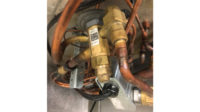The TXV needs to be selected to match the Btu capacity of the system’s evaporator and compressor. Normally, these valves are rated in tons of refrigeration, so you need to remember that 1 ton of refrigeration equals 12,000 Btuh.
The capacity of a TXV is based on the following system characteristics:
• refrigerant type,
• evaporating temperature,
• liquid temperature entering the valve, and
• pressure drop across the valve.
Capacity
Valve manufacturers will provide a rating chart for the various valves they produce. Typically these charts will show the capacity of a valve-based refrigerant type, at a specific evaporating temperature.
For example: A system is designed to use HFC-134a and the Btu capacity of the compressor and evaporator is approximately 15,000 Btuh at a 20-degree F evaporating temperature. Using the chart in Figure 1, we would select the model ER48 valve. Its rated capacity is 1.31 tons, which equals 15,720 Btuh.
These charts are based on a specific liquid refrigerant temperature entering the valve, usually 100 degrees. If the highest expected refrigerant temperature entering the valve will not be the specific value given by the manufacturer (again usually 100 degrees), a multiple needs to be applied to adjust the valve’s rated capacity. This is usually given in a separate chart.
If the highest expected refrigerant temperature entering the valve in our example is 90 degrees, we would need to adjust the valve’s capacity by a factor of 1.08, which would increase the selected valve’s capacity to 16,977 Btuh (1.08 x 15720 Btuh) (see Figure 2).
The actual pressure drop across a valve also affects its capacity. Another multiplier may need to be applied if the pressure drop across the valve is different from the standard value used by the manufacturer. When determining the pressure drop, use the system’s minimum operating condensing pressure subtracted from the system’s evaporating pressure. Be sure to use the expected pressures directly at the valve’s inlet and outlet.
In our example, if the minimum pressure drop across our valve will be 60 psig, we would need to adjust the valve’s capacity by a factor of 0.92, which would decrease the selected valve’s capacity to 15,618 Btuh (0.92 x 16,977 Btuh) (see Figure 3).
Once the right capacity is selected, you will need to determine the desired body type (flanged, flared, soldered, straight, angled, etc.) and if the valve selected needs to be an internally or externally equalized valve. The amount of pressure drop between the valve outlet and its sensing bulb location will determine the type of equalization required. An internally equalized valve can be used only on single circuit evaporators having a pressure drop no greater than the equivalent of a 2 degree saturated temperature change across its coil. On single circuited coils with a greater pressure drop and all multicircuited coils, an externally equalized valve is normally required.
Power
The last consideration for selecting a TXV is the type of power element needed. Manufacturers will provide recommendations for the correct power element based on the system application. This selection is based on the type of refrigerant used and the temperature range of the application. Continuing with the example, we would choose a power element recommended for an R-134a system being used on a commercial refrigeration system (50 degrees to -10 degrees).
Selecting the right metering device is an important part of properly designing and installing refrigeration systems. Failure to choose the right device will lead to system problems, unhappy customers, and lost sales.
Publication date: 04/02/2012









